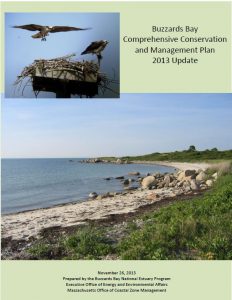2013 CCMP, Action Plan 20:
Monitoring Management Action, Status, and Trends
About the new Buzzards Bay CCMP Action Plans
The Buzzards Bay Comprehensive Conservation and Management Plan (CCMP) was updated in November 2013 to reflect the great progress achieved since the original CCMP was finalized. You can download the entire document (buzzards-bay-ccmp-2013-update.pdf) or just this action plan Monitoring Management Action, Status and Trends.
Monitoring Management Action, Status, and Trends
Problem
Monitoring is used to track the effectiveness of management action or inaction. For Clean Water Act initiatives like the National Estuary Program, a key question has always been, “Are we making waters more fishable and swimmable?” This question is understood as whether government is preserving and protecting ecosystem health and the integrity of the natural environment, and whether waters meet specified “designated uses.” An especially difficult challenge in all environmental monitoring programs is recognizing that static environmental conditions in the face of new development or pollution inputs is in itself a measurable success.
Increasingly, funding agencies want to know not only whether a project was completed successfully, but also whether it was successful in protecting or restoring the environment. In fact, the 1987 amendments to the Clean Water Act section 320(b)(6) specified that each NEP Management Conference shall “…monitor the effectiveness of actions taken pursuant to the plan,” to meet these two goals: “measure the effectiveness of the management actions and programs implemented under the [CCMP]; and provide essential information that can be used to redirect and refocus the CCMP during implementation.” Implicit in these requirements are programmatic monitoring, environmental monitoring, and some level of research to ensure that selected environmental monitoring is adequately characterizing environmental conditions and risks.
Each action plan in the Buzzards Bay CCMP includes monitoring strategies. This action plan reiterates some of the most important elements of other action plans, but also addresses some broader watershed monitoring and reporting needs to meet the broader goals of the Buzzards Bay CCMP.
Goals
Goal 20.1. To document environmental trends of water quality and living resources in order to assess the effectiveness of management actions taken, or identify the need for new actions.
Goal 20.2. Identify research and monitoring needs to understand more clearly the causes of impairments, reduce uncertainties about health risks, and better define conditions in Buzzards Bay.
Objectives
Objective 20.1. Collect and monitor programmatic actions to document implementation of Buzzards Bay CCMP recommended actions.
Objective 20.2. Ensure that regulatory agencies define essential monitoring requirements and collect data necessary to evaluate program and project success.
Objective 20.3. Ensure that funding is available to implement essential monitoring programs.
Objective 20.4. Revise and adapt monitoring programs to meet changing needs and information gaps.
Objective 20.5. Disseminate data and syntheses of information to scientists, managers, and the public.
Objective 20.6. Encourage scientists and agencies to evaluate emerging contaminants and other stressors to the environment.
Approaches
Shellfish bed closures, eutrophication data, and eelgrass bed cover are some of the key water quality measures that must be tracked, but in the long run, the state’s list of impaired waters (as river miles and water acres) will be the ultimate measure of success of actions taken to comply with the Clean Water Act. This also means considerable effort will be needed to monitor and characterize the many unassessed freshwater and marine bodies in the bay and watershed.
While programmatic and environmental data are col-lected by the U.S. EPA, the Buzzards Bay Coalition, Buzzards Bay NEP, and DEP, more effort is needed to make this information available on line, and where needed, synthesizing and aggregating data to show watershed comparisons and trends in time.
Programmatic actions by municipalities to comply with permits and watershed TMDL goals are both short-term and long-term measures to be tracked. Government will need to expand funding to research institutions to enable managers to better discern threats from emerging issues and concerns.
Costs and Financing
Tracking programmatic actions has modest costs. The cost of field monitoring described in the various action plans in the Buzzards Bay CCMP may total hundreds of thousands of dollars annually. Some monitoring needs can be met through new permit requirements, research grants may assist in evaluating contaminants of emerging concern, or federal watershed assessment grants (604b), but most monitoring costs must be borne by agencies managing the environment.
Measuring Success
The measure of success for this action plan will be whether sufficient information exists to evaluate the success of each action plan in this Buzzards Bay CCMP.
